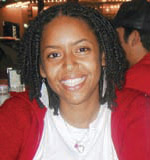Commentary: Krystle Williams
 |
| Photo courtesy of: Krystle Williams |
Putting a new face on physics
What will the physics community look like 10 years from now? What should it look like? With the adoption of the theme “Future Faces of Physics,” these are the questions the Society of Physics Students (SPS) is encouraging you to ask yourself.
In the recent report Beyond Bias and Barriers, the National Academies noted that “to maintain its scientific and engineering leadership amid increasing economic and educational globalization, the United States must aggressively pursue the innovative capacity of all of its people-women and men...It is essential that our academic institutions promote the educational and professional success of all people without regard for sex, race, or ethnicity.” The report also stressed the need for professional scientific societies to take a leading role in addressing issues of diversity.
SPS has recognized diversity as an issue of importance for some time now. For three years we have discussed issues relating to diversity at the SPS National Council meeting. In 2007-08, the National Council is calling on students and leaders of the physics community to discuss and act on a wide range of student diversity issues, such as making physics communities more welcoming and encouraging widespread discourse.
Physics suffers from a unique set of diversity issues. You've probably heard the statistics–although women account for more than 60 percent of all bachelor's degrees granted, they receive only 20 percent of bachelor's degrees in physics. Students from underrepresented minorities receive only 12 percent of physics bachelor's degrees. Students from low-income families and students with disabilities rarely earn degrees in physics. These percentages decline further with each step up the academic ladder.
Why is this? And what can you do to help?
One reason is cited in a September 2003 Physics Today article titled “What Works for Women in Undergraduate Physics?” It describes a “leaky pipeline” caused by lack of an inclusive culture in university physics departments, among other things.
SPS has started a grassroots effort to alleviate this disparity. Most of our members are undergraduates, at a stage when the majority of students who studied physics in high school opt out of the field. We are especially equipped to focus on this issue, since local SPS chapters are usually where physics students make initial contact with the broader physics community. Studies have also shown that community outreach and mentor relationships are important for encouraging the participation of underrepresented groups in science, and both are primary activities for local SPS chapters.
SPS is engaged in a “Year of Dialogue on Student Diversity in Physics,” and we intend to spark these conversations through workshops at every SPS Zone Meeting in 2008. More than a dozen zone meetings are held each year, often in conjunction with sectional meetings of the American Association of Physics Teachers and the American Physical Society. This allows us to engage both students and professionals in this essential dialogue.
One of the supporting materials SPS created for the workshops is “Jeo-party,” a quiz modeled after the TV game show Jeopardy with questions ranging from basic problems in physics to the field's history, diversity, and place in pop culture. One example:
| This iconic physicist was engaged in many civil rights activities and co-chaired the American crusade to end lynching. |
Think you know the answer–or, rather, the question? “Who is Albert Einstein?” is always a good answer when asked about an historic physics figure, and in this case it is right!
We anticipate that participants will take the game and their ideas back to their local communities so the diversity discussion can continue. Students will have a chance to share their diversity efforts at a poster session and event during the Sigma Pi Sigma Quadrennial Congress in November 2008 at Fermi National Accelerator Laboratory in Illinois. This is a very exciting year for SPS. It is our hope that we will truly engage the physics community in a significant exchange of ideas.
I'll leave you with one more answer from Jeo-party:
| The guitarist from this legendary band recently received his PhD in astrophysics. |
Don't know the question? You'll just have to attend a “Future Faces of Physics” workshop to find out!
Krystle Williams is a second-year graduate student in the biophysics program at the University of Rochester. She has served on the Society of Physics Students National Council for three years.
Click here to download the pdf version of this article.


